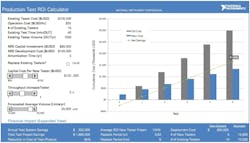Putting real numbers to the total-cost-of-ownership equation
What comes to mind when a salesperson wants to talk to you about “total cost of ownership”? Perhaps you would expect to hear a justification for sky-high upfront costs with vague promises of savings a decade ahead.
However, TCO is defined by an equation—it equals upfront costs plus deployment costs plus operational costs, and it’s possible to assign real numbers to each variable. You don’t have to accept vague promises of future savings. You can calculate those savings to see whether an investment now makes sense and over what time period it will pay off.
Total cost of ownership is the topic of a webcast to be presented 11 a.m. EDT Wednesday March 22 by Chad Ruwe, responsible for business and test strategy at National Instruments. He will cover the pressures facing test engineering organizations today. He will present specific examples, including a look at the total cost perspective of a test project whose upfront costs were $400k. He will also present the example of an existing rack-and-stack system vs. a new PXI system that cuts test time and increases throughput.A key part of the presentation is a production test ROI calculator that would let you experiment with various parameters—such as capital costs per new tester, throughput, and average annual volume—letting you see if and when a new tester would save you money.
He will also discuss business and technology issues and offer suggestions for optimizing test organizations.
Attendees can ask questions throughout the event. To register, click here.
About the Author

Rick Nelson
Contributing Editor
Rick is currently Contributing Technical Editor. He was Executive Editor for EE in 2011-2018. Previously he served on several publications, including EDN and Vision Systems Design, and has received awards for signed editorials from the American Society of Business Publication Editors. He began as a design engineer at General Electric and Litton Industries and earned a BSEE degree from Penn State.

